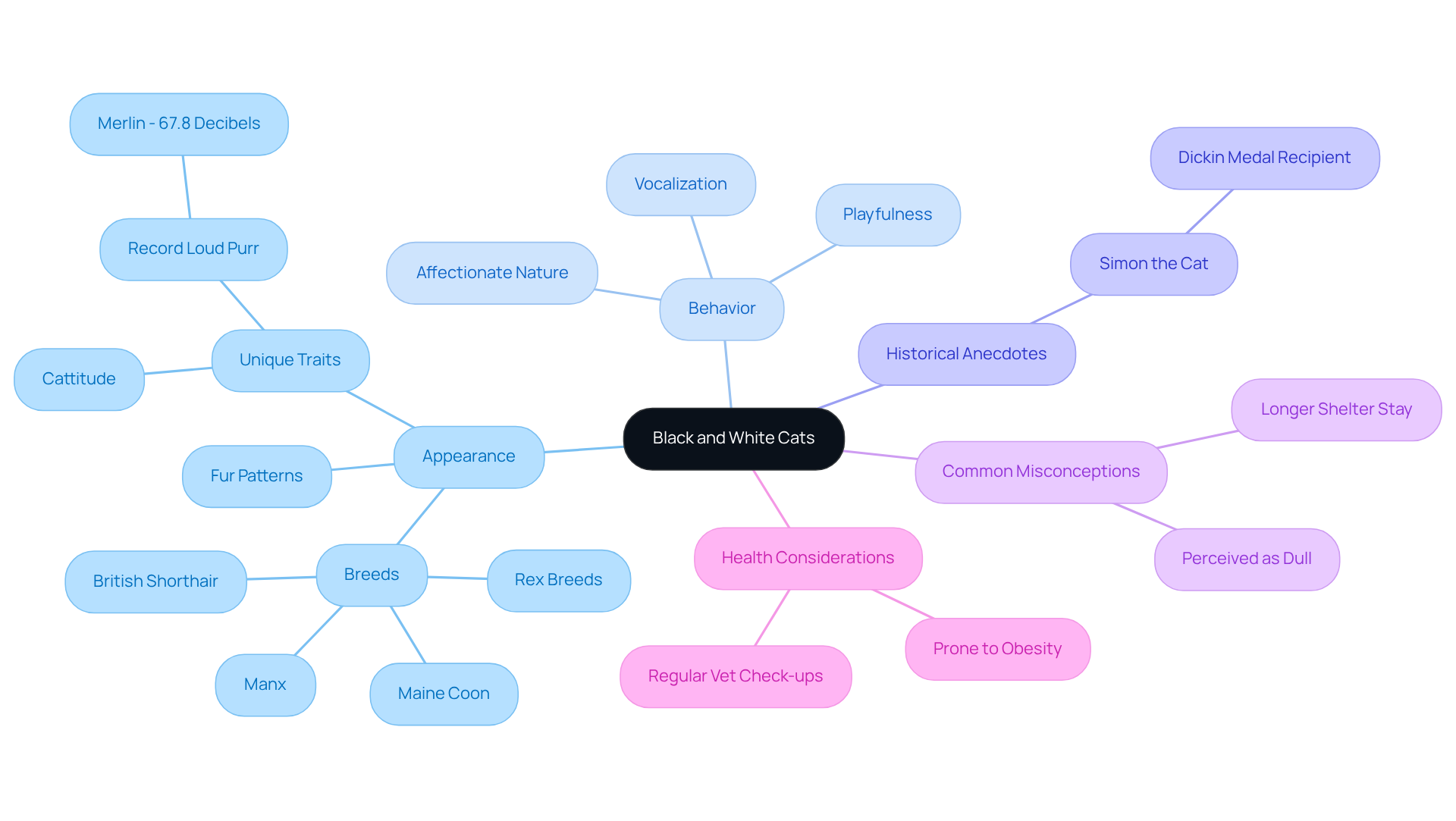Essential Care for Black and White Cats: Traits and Guidelines
Overview
This article lovingly highlights the essential care guidelines and unique traits of black and white cats, showcasing their playful and affectionate nature, as well as their specific care needs. It compassionately underscores the importance of:
- Regular grooming
- A balanced diet
- Hydration
- Mental stimulation
- Veterinary check-ups
to ensure the well-being of these beloved cats. Additionally, it addresses common misconceptions that can hinder their adoption rates, fostering a deeper understanding and connection with potential pet owners.
Introduction
Black and white cats, often affectionately dubbed “tuxedo felines,” not only capture our attention with their striking appearance but also enchant us with their captivating personalities and unique behaviors. These charming companions, found across various breeds, are known for their playful and affectionate nature, making them beloved members of many households.
Yet, despite their popularity, misconceptions about their temperament and care needs can hinder their chances of finding forever homes. How can you, as a caring pet owner, ensure that these delightful cats receive the love, attention, and proper care they truly deserve?
This article delves into the essential characteristics and care guidelines for black and white cats, shedding light on their health needs, grooming tips, and behavioral traits that make them truly special.
Explore the Unique Characteristics of Black and White Cats
Black and cream felines, often lovingly referred to as formal wear felines, are celebrated for their stunning two-tone fur, which varies greatly in design and texture. The classic formal pattern showcases a predominantly black body adorned with white paws, chest, and belly, reminiscent of elegant attire. While tuxedo felines are not a distinct breed, they can be found among various breeds, including the British Shorthair and Maine Coon, enriching the diversity of our furry family members.
These charming felines are often characterized by their playful, loving, and clever natures, making them cherished companions. Recent research indicates that felines with darker and lighter shades may exhibit unique behavioral traits, such as a tendency to be more vocal and sociable than their differently hued counterparts. For instance, a study involving 1,274 feline owners revealed that tuxedo-patterned felines were among the most likely to display affectionate behaviors on their own terms, showcasing their distinct ‘cattitude’—a delightful personality trait that pet owners adore.
Interestingly, a British tuxedo feline named Merlin holds the record for the world’s loudest purr at an impressive 67.8 decibels, highlighting the unique characteristics that make these animals so special. Additionally, the historical tale of Simon, a monochrome feline honored with the Dickin Medal for safeguarding sailors’ food supply during World War Two, illustrates the significant contributions these animals make beyond their appearance.
Despite their undeniable charm, these monochrome felines often face misconceptions that they are dull, which can complicate their re-homing compared to more exotic-looking animals. In reality, black and white cats may comprise 70% or more of all felines, showcasing their commonality and appeal. Regular veterinary check-ups are vital for black and white cats, as they may be prone to specific health issues, including obesity, if not properly managed. Their playful nature and social tendencies bring joy to any household, but ensuring they receive ample exercise and mental stimulation is crucial for their well-being. With their delightful personalities and distinctive looks, these felines continue to capture the hearts of pet owners everywhere.

Essential Care Guidelines for Black and White Cats
Caring for black and white cats is a rewarding journey that involves several key practices to ensure their well-being.
- Regular Grooming: To keep your furry family members looking their best, brush their coats at least once a week. This not only prevents matting and reduces shedding, especially for long-haired varieties, but also helps maintain a healthy coat and minimizes hairballs. With their unique coat patterns, such as those seen in black and white cats with tuxedo and mask and mantle styles, different grooming methods may be necessary to cater to their individual needs.
- Balanced Diet: Providing high-quality cat food that meets their nutritional needs is essential, focusing on protein-rich options. It’s important to monitor their weight closely to prevent obesity, a common concern for indoor felines. Remember, your dark and light companions can live between 10 and 20 years, so a balanced diet is vital for their long-term health.
- Hydration: Always ensure your cat has access to fresh water. Consider a cat water fountain to encourage drinking, promoting better hydration and overall health.
- Litter Box Maintenance: Keep the litter box clean and odor-free by scooping daily and changing the litter regularly. This not only promotes good hygiene but also encourages your cat to use the box consistently.
- Regular Vet Visits: Schedule annual check-ups to monitor health and vaccinations. If you notice any behavioral changes, discuss them with your vet, as they can indicate underlying health issues that need attention. It’s worth noting that black and white cats, along with other dark felines, often face challenges in finding homes, as they may require more time to be adopted. Alice Potter, an RSPCA feline welfare expert, emphasizes the importance of proper care to help these animals find loving homes.
- Mental Stimulation: Engage your cat with toys and interactive play to keep them mentally stimulated and prevent boredom. Activities like puzzle feeders can enhance their cognitive skills while providing entertainment.
By embracing these practices, you create a nurturing environment that supports the health and happiness of your beloved cats.

Understanding the Behavioral Traits of Black and White Cats
Black and gray felines exhibit a variety of behavioral traits, often shaped by their environment and upbringing. Understanding these characteristics can help you create a nurturing environment for your furry family members. Here are some key traits to consider:
- Affectionate Nature: Many black and white cats are known for their loving behavior, actively seeking companionship and affection from their human family. They often form strong bonds with their owners. Interestingly, the Journal of Applied Animal Welfare Science notes that “dark and light felines were less accepting of being handled by their humans, and preferred to show affection on their terms.”
- Playfulness: These lively animals typically enjoy interactive play, making them wonderful companions for families and individuals who appreciate an active pet.
- Vocalization: Research indicates that felines with contrasting colors may be more vocal than others, frequently meowing and purring to express their needs and desires.
- Curiosity: Their inquisitive nature drives them to explore their surroundings, leading to playful mischief and delightful discoveries.
- Social Behavior: Generally sociable, monochrome felines tend to get along well with other pets, including dogs, especially when introduced at a young age.
- Sensitivity: While many are friendly, some felines with distinct coloring may be sensitive to handling and prefer to engage on their own terms. Recognizing and respecting these boundaries is crucial for building a trusting relationship. Additionally, studies have shown that black and white cats, particularly those with tuxedo patterns, were rated as the most aggressive, which may influence their interactions with humans and other pets.
By understanding these traits, you can make informed decisions when considering adoption. It’s essential to remember that societal biases can affect the adoption rates of these cats. At Adventure Den, we are here to support you in providing a loving and understanding home for your new companion.

Conclusion
Caring for black and white cats transcends their striking appearance; it involves understanding their unique traits and providing essential care that ensures their health and happiness. These charming felines, often characterized by their affectionate and playful nature, deserve recognition for their individuality and the proper care that supports their well-being throughout their lives.
Key insights from this article highlight the importance of:
- Regular grooming
- A balanced diet
- Mental stimulation tailored to the specific needs of your furry family members
Their distinctive personalities, which can include vocalization and curiosity, further emphasize the necessity of engaging with them in a way that respects their boundaries and preferences. Additionally, understanding the societal biases they face can help foster a more compassionate approach to their care and adoption.
Ultimately, embracing the unique characteristics and care requirements of black and white cats not only enriches the lives of these beloved companions but also enhances the joy they bring into our homes. By prioritizing their health and happiness, pet owners can ensure that these remarkable felines thrive, creating a lasting bond that celebrates their charm and individuality.
Frequently Asked Questions
What are the unique characteristics of black and white cats?
Black and white cats, often called formal wear felines, are known for their stunning two-tone fur, which can vary in design and texture. The classic tuxedo pattern features a predominantly black body with white paws, chest, and belly.
Are tuxedo cats a specific breed?
No, tuxedo cats are not a distinct breed. They can be found among various breeds, including the British Shorthair and Maine Coon.
What personality traits are commonly associated with black and white cats?
Black and white cats are often playful, loving, and clever. They tend to be more vocal and sociable compared to cats of other colors, displaying affectionate behaviors.
Can you provide an example of a famous black and white cat?
Merlin, a British tuxedo feline, holds the record for the world’s loudest purr at 67.8 decibels, showcasing the unique characteristics of these cats.
What historical significance do black and white cats have?
One notable example is Simon, a monochrome feline who received the Dickin Medal for his role in safeguarding sailors’ food supply during World War Two.
Do black and white cats face any misconceptions?
Yes, they often face misconceptions that they are dull, which can make re-homing them more challenging compared to more exotic-looking animals.
How common are black and white cats?
Black and white cats may comprise 70% or more of all felines, highlighting their commonality and appeal.
What health issues should be monitored in black and white cats?
Regular veterinary check-ups are important as black and white cats may be prone to specific health issues, including obesity, if not properly managed.
What is important for the well-being of black and white cats?
Ensuring they receive ample exercise and mental stimulation is crucial for their well-being, as their playful nature and social tendencies bring joy to households.







